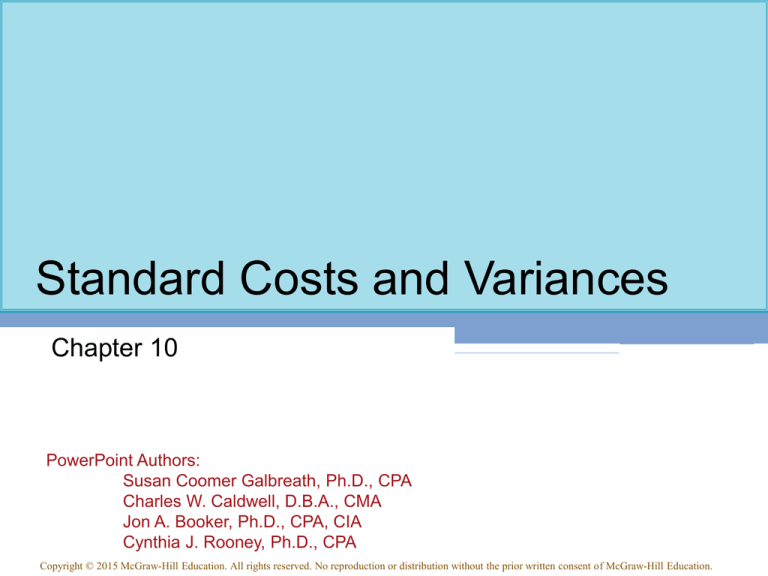
Standard Costs and Variances
Chapter 10
PowerPoint Authors:
Susan Coomer Galbreath, Ph.D., CPA
Charles W. Caldwell, D.B.A., CMA
Jon A. Booker, Ph.D., CPA, CIA
Cynthia J. Rooney, Ph.D., CPA
Copyright © 2015 McGraw-Hill Education. All rights reserved. No reproduction or distribution without the prior written consent of McGraw-Hill Education.
10-2
Standard Costs
Standards are benchmarks or “norms” for
measuring performance. In managerial accounting,
two types of standards are commonly used.
Price standards
specify how much
should be paid for
each unit of the
input.
Quantity standards
specify how much of an
input should be used to
make a product or
provide a service.
Examples: Firestone, Sears, McDonald’s, hospitals,
construction, and manufacturing companies.
10-3
Setting Direct Materials Standards
Standard Price
per Unit
Standard Quantity
per Unit
Final, delivered
cost of materials,
net of discounts.
Summarized in
a Bill of Materials.
10-4
Setting Direct Labor Standards
Standard Rate
per Hour
Standard Hours
per Unit
Often a single
rate is used that reflects
the mix of wages earned.
Use time and
motion studies for
each labor operation.
10-5
Setting Variable Manufacturing
Overhead Standards
Price
Standard
Quantity
Standard
The rate is the
variable portion of the
predetermined overhead
rate.
The quantity is
the activity in the
allocation base for
predetermined overhead.
10-6
A General Model for Variance Analysis
Variance Analysis
Price Variance
Quantity Variance
Difference between
actual price and
standard price
Difference between
actual quantity and
standard quantity
10-7
Price and Quantity Standards
Price and quantity standards are
determined separately for two reasons:
The purchasing manager is responsible for raw
material purchase prices and the production manager
is responsible for the quantity of raw material used.
The buying and using activities occur at different times.
Raw material purchases may be held in inventory for a
period of time before being used in production.
10-8
A General Model for Variance Analysis
Variance Analysis
Price Variance
Quantity Variance
Materials price variance
Labor rate variance
VOH rate variance
Materials quantity variance
Labor efficiency variance
VOH efficiency variance
10-9
A General Model for Variance Analysis
(1)
Actual Quantity
of Input,
at Actual Price
(AQ × AP)
(2)
Actual Quantity
of Input,
at Standard Price
(AQ × SP)
Price Variance
(2) – (1)
(3)
Standard Quantity
Allowed for Actual Output,
at Standard Price
(SQ × SP)
Quantity Variance
(3) – (2)
Spending Variance
(3) – (1)
10-10
A General Model for Variance Analysis
Actual quantity is the amount of direct materials, direct
labor, and variable manufacturing overhead actually used.
(1)
Actual Quantity
of Input,
at Actual Price
(AQ × AP)
(2)
Actual Quantity
of Input,
at Standard Price
(AQ × SP)
Price Variance
(2) – (1)
(3)
Standard Quantity
Allowed for Actual Output,
at Standard Price
(SQ × SP)
Quantity Variance
(3) – (2)
Spending Variance
(3) – (1)
10-11
A General Model for Variance Analysis
Standard quantity is the standard quantity allowed
for the actual output of the period.
(1)
Actual Quantity
of Input,
at Actual Price
(AQ × AP)
(2)
Actual Quantity
of Input,
at Standard Price
(AQ × SP)
Price Variance
(2) – (1)
(3)
Standard Quantity
Allowed for Actual Output,
at Standard Price
(SQ × SP)
Quantity Variance
(3) – (2)
Spending Variance
(3) – (1)
10-12
A General Model for Variance Analysis
Actual price is the amount actually
paid for the input used.
(1)
Actual Quantity
of Input,
at Actual Price
(AQ × AP)
(2)
Actual Quantity
of Input,
at Standard Price
(AQ × SP)
Price Variance
(2) – (1)
(3)
Standard Quantity
Allowed for Actual Output,
at Standard Price
(SQ × SP)
Quantity Variance
(3) – (2)
Spending Variance
(3) – (1)
10-13
A General Model for Variance Analysis
Standard price is the amount that should
have been paid for the input used.
(1)
Actual Quantity
of Input,
at Actual Price
(AQ × AP)
(2)
Actual Quantity
of Input,
at Standard Price
(AQ × SP)
Price Variance
(2) – (1)
(3)
Standard Quantity
Allowed for Actual Output,
at Standard Price
(SQ × SP)
Quantity Variance
(3) – (2)
Spending Variance
(3) – (1)
10-14
Responsibility for Materials
Variances
Materials Price Variance
Purchasing Manager
Materials Quantity Variance
Production Manager
The standard price is used to compute the quantity variance
so that the production manager is not held responsible for
the purchasing manager’s performance.
10-15
Responsibility for Labor Variances
Production managers are
usually held accountable
for labor variances
because they can
influence the:
Mix of skill levels
assigned to work tasks.
Level of employee
motivation.
Quality of production
supervision.
Production Manager
Quality of training
provided to employees.
10-16
Advantages of Standard Costs
Standards can
provide benchmarks
that promote economy
and efficiency.
Standard costs are
a key element of
the management by
exception approach.
Advantages
Standards can
greatly simplify
bookkeeping.
Standards can
support responsibility
accounting systems.
10-17
Potential Problems with Standard
Costs
Standard cost variance
reports are usually
prepared on a monthly
basis and may contain
information that is
outdated.
Potential
Problems
If variances are misused
as a club to negatively
reinforce employees,
morale may suffer and
employees may make
dysfunctional decisions.
Labor variances assume that the production process is labor-paced
and that labor is a variable cost. These assumptions are often invalid
in today’s automated manufacturing environment where employees
are essentially a fixed cost.
10-18
Potential Problems with Standard
Costs
Just meeting standards
may not be sufficient;
continuous improvement
may be necessary to
survive in a competitive
environment.
Potential
Problems
In some cases, a
“favorable” variance
can be as bad or
worse than an
unfavorable variance.
Excessive emphasis on meeting the standards may overshadow other
important objectives such as maintaining and improving quality,
on-time delivery, and customer satisfaction.
10-19
End of Chapter 10






